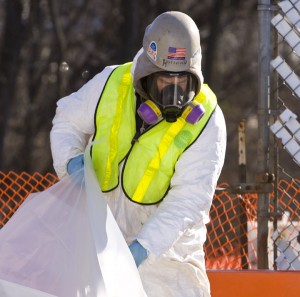Another Ticking Chemical Timebomb Goes Off in NJ
[Update: 2/21/11 – The Atlantic City Press reports on another bomb that went off – and instead of responding and doing theri job, DEP irresponsibly ducked again and dumped the problem in the County’s lap. See: Port Republic officials say oil leak may force teardown of City Hall
The spill occurred in late January when oil leaked into the ground through a small hole in an above-ground tank. A new tank was installed and a cleanup occurred. A week later, the building was shut down after employees who work at the Main Street building complained of nausea and headaches.
Larry Hajna, a spokesman for the state Department of Environmental Protection, said the state was alerted about the spill and referred cleanup efforts to Atlantic County. County Emergency Preparedness Director Vincent Jones could not be reached for comment last week.
It’s groundhog day at the nation’s most notorious toxic waste site – Love Canal:[full story]
Contamination related to Love Canal found in LaSalle – ˜Volatile organic compounds” stemming from Love Canal found during routine pipe work
NIAGARA FALLS – A chemical compound found by a contractor working in a LaSalle neighborhood has been connected to Love Canal-era contamination, multiple sources confirmed to the Niagara Gazette on Thursday.
The substance was found last week when a Niagara Falls Water Board contractor, working in the vicinity of the 70-acre Love Canal containment structure, broke into a clay pipe, releasing a chemical compound.
The compound released from the pipe produced an odor which could be smelled blocks away from the site of the excavation, the contractor said.
The fact that history repeated itself at Love Canal came as a shock to many, so I assume that people would be suprised to learn that a technically similar – but far less well known – case was reported this week in a story from the Belleville Times. That story shows that another ticking chemical timebomb has gone off.
For the statewide context for this local story, see: NEW JERSEY CLOSING ITS NOSE TO VAPOR INTRUSION CRISIS – Vapor Intrusion Rules Cast into Regulatory Limbo as Horror Stories Multiply
Belleville urges Walter-Kidde neighbors to take precaution [click for full story]
Homes and businesses near the former Walter Kidde industrial site may be contaminated by a cancer-causing chemical, trichloroethylene, according to Belleville officials.
DALE MINCEY/BELLEVILLE TIMESTCE, which removes grease from metal parts, can cause nerve, kidney, and liver damage when inhaled for “long periods” of time, according to the Agency for Toxic Substances & Disease Registry. Clinical studies on mice and rats have further suggested that “high levels” of TCE can result in liver, kidney or lung cancer.
Neighboring property owners believed to be at risk received a letter from the Belleville Department of Health last week. They were invited to attend an information session on Wednesday. About 16 residents showed up, along with several township officials, and the environmental specialist and attorney representing Belleville in a complaint against the site’s current owners.
“Two people in my house had cancer in the last 10 years, and when I read this…” said resident Diane Bruno. “We thought this was said and done,” she added of the issues surrounding the site.
History
The township and the Department of Environmental Protection knew for years that there was some groundwater contamination at the former Walter Kidde site, located at 675 Main St., township officials said. However, DEP officials had said the “chlorinated solvent” in the groundwater was contained to the Walter Kidde land and posed no imminent danger to neighbors.
“Groundwater moves, but as far as we know, it’s currently [staying] on the property,” DEP spokesman Larry Hagna told the Times in October.
Since then, the township has discovered that the current owners “hid” some information pertinent to their property’s contamination, Township Attorney Thomas Murphy said.
This is another example of negligent oversight and borderline criminal incompetence at the DEP cleanup program.
We predicted this and issued warnings almost 5 years ago: MERCURY-LADEN DAY-CARE CENTER IN NEW JERSEY IS NO ANOMALY – Lax State Brownfield Laws Make Tragedy an Accident Waiting to Happen
This is yet another example of “vapor intrusion” – how chemicals can migrate through groundwater, soil, and along infrastructure to poison people in buildings without their knowledge.
The NJ vapor intrusion poster child is the Dupont site, in Pompton Lakes, where 450 or more homes have been poisoned and elevated cancer rates have been documented by State health officials.
DEP knows exactly where all these potential “vapor intrusion” sites are located.
The sites (i.e. sites with known volatile organic chemicals in groundwater) are mapped in DEP’s Geographic Information System (GIS) data layers (hit this link – scroll down for “groundwater contamination areas“). (Here is DEP GIS FAQ, which identifies software needed to access these maps)
Despite these known health risks, DEP refuses to act proactively to get control of these sites and warn people who live nearby who are being poisoned.
Again, local officials were unaware of what was going on at a highly contaminated site and forced to act and warn their residents – all because DEP failed to do so.
This DEP failure to act is an outrage (see “A Big Map for Toxic Site Cleanup“).
DEP knows exactly what needs to be done (but is doing the opposite – even weakening groundwater cleanup requirements).
History
Back in 2007, in the wake of the Kiddie Kollege scandal, where 60 toddlers were poisoned by chemical vapors in a daycare center (located in a former industrial mercury battery manufacturing building, which was a known toxic site where that DEP failed to monitor or enforce a cleanup Order) DEP conducted a statewide vapor intrusion investigation.
But that 2007 investigation was very narrowly targeted at daycare centers and schools (see: 60 MORE NEW JERSEY DAY-CARE CENTERS NAMED ON TOXIC WARNINGS – Hundreds of Homes, Schools and Other Facilities May Also Be Vulnerable
Immediate Reforms Needed
DEP must conduct a real statewide vapor intrusion investigation and response, including:
- mapping all potential sites and surrounding homes and buildings;
- warning local officials and surrounding neighbors of the risks;
- sampling building interiors;
- installing vapor mitigation systems; and
- enforcing cleanup requirements adn making polluters pay.
DEP can no longer sit back and wait for polluters to develop cleanup plans – they have shown no interest in cleanups and do everything possible to avoid, delay, or reduce cleanup costs.
Call your legislators and demand a statewide investigation. DEP knows where all these ticking timebombs are located.





